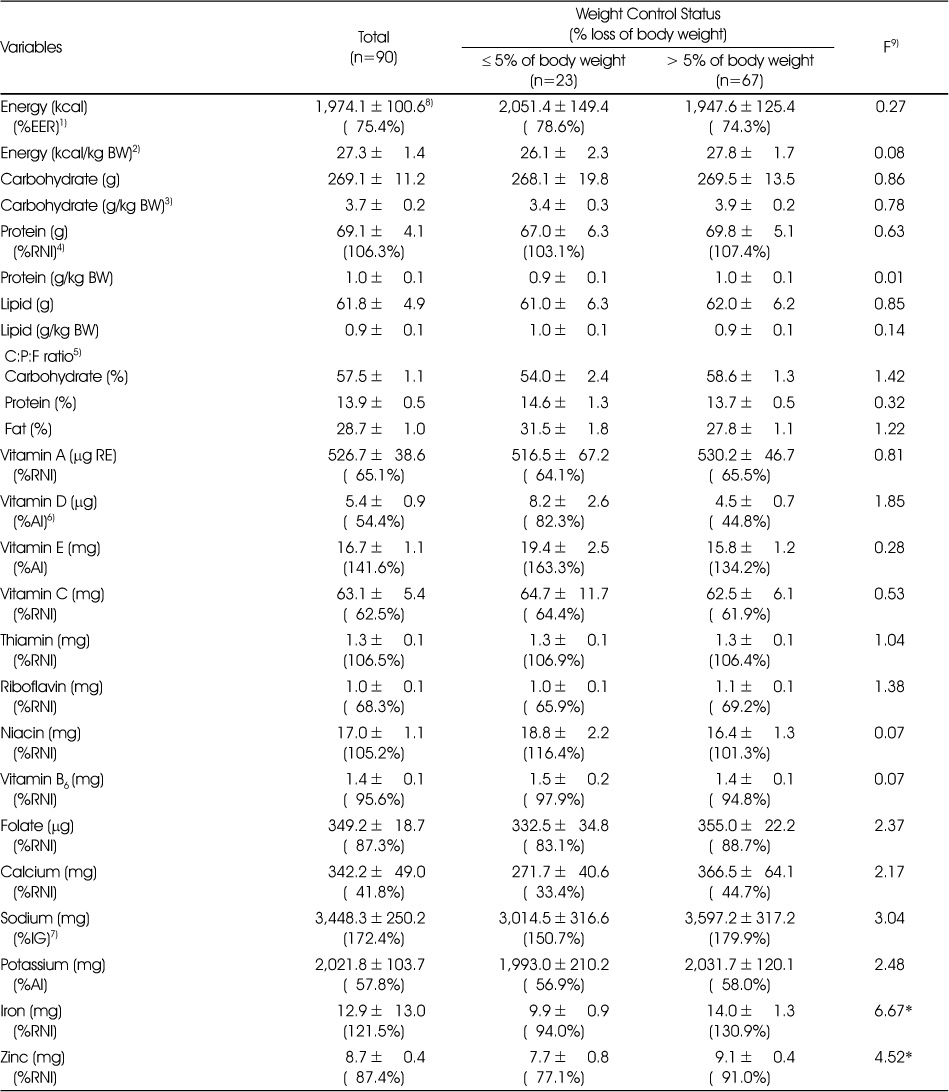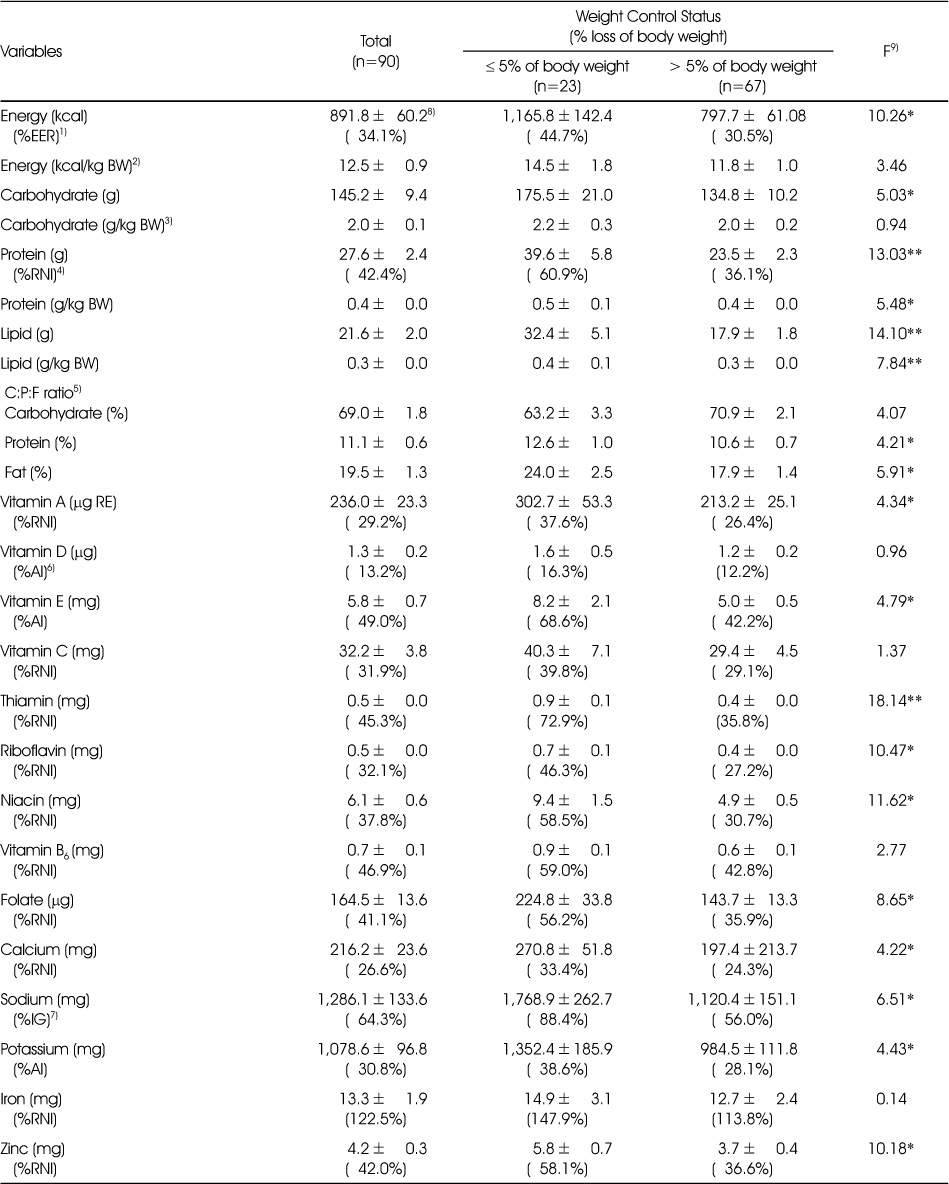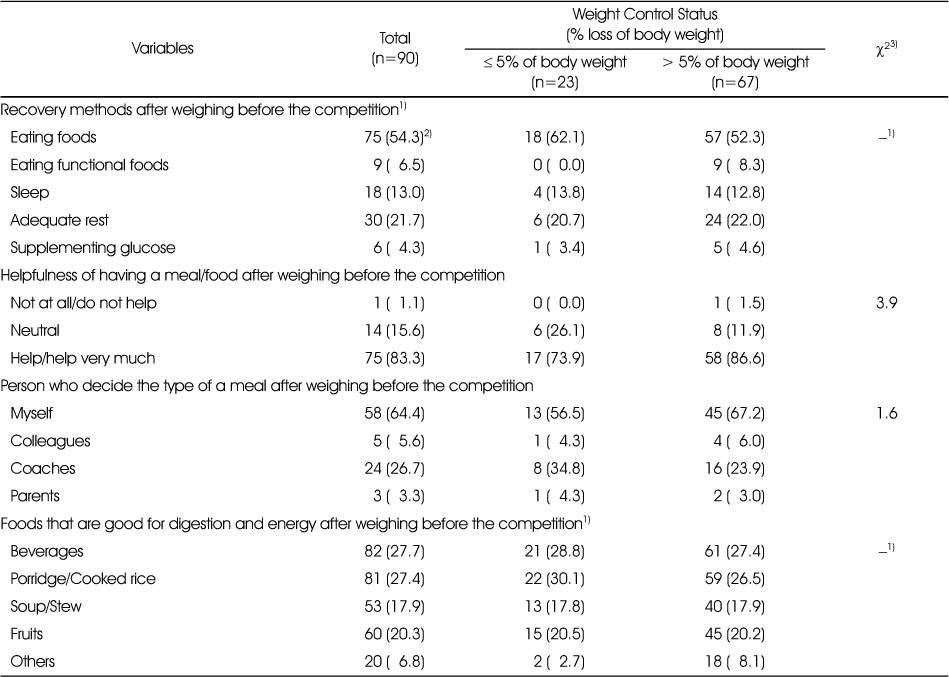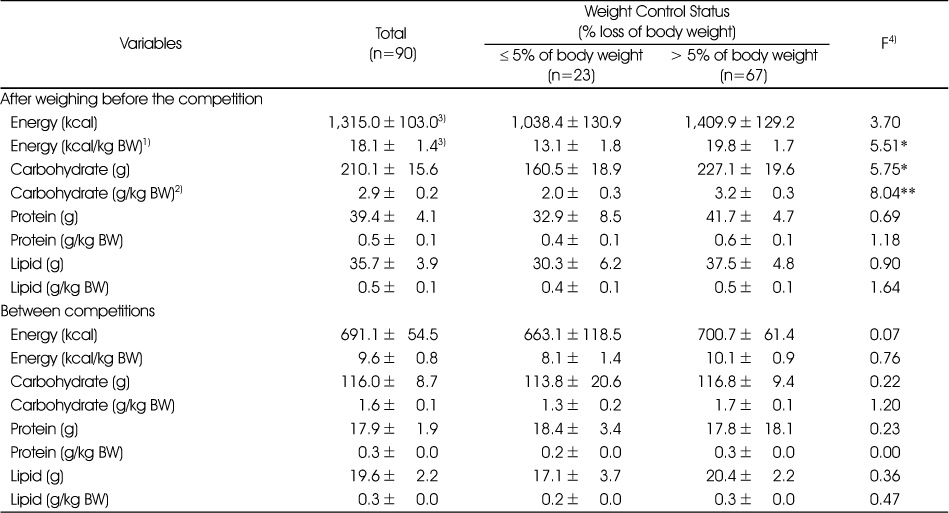Articles
- Page Path
- HOME > Korean J Community Nutr > Volume 22(6); 2017 > Article
-
Research Article
- Nutrient Intakes of Male College Combat Sport Athletes by Weight Control Status
-
Ji Yeon Kim, Ji Seon Lee, Seong Suk Cho, Hyon Park, Kyung Won Kim

-
Korean Journal of Community Nutrition 2017;22(6):495-506.
DOI: https://doi.org/10.5720/kjcn.2017.22.6.495
Published online: December 31, 2017
Food and Nutrition, Seoul Women's University, Seoul, Korea.
1National Training Center of Korea Olympic Committee, Seoul, Korea.
2Sports Medicine, Kyung Hee University, Yongin, Korea.
- Corresponding author: Kyung Won Kim. Food and Nutrition, College of Natural Sciences, Seoul Women's University, 621 Hwarang-ro, Nowon-gu, Seoul 01797, Korea. Tel: (02) 970-5647, Fax: (02) 976-4049, kwkim@swu.ac.kr
Copyright © 2017 The Korean Society of Community Nutrition
This is an Open-Access article distributed under the terms of the Creative Commons Attribution Non-Commercial License (http://creativecommons.org/licenses/by-nc/3.0/) which permits unrestricted non-commercial use, distribution, and reproduction in any medium, provided the original work is properly cited.
- 117 Views
- 2 Download
- 1 Crossref
Abstract
-
Objectives
- Weight control practices are common in combat sport athletes. This study was performed to examine nutrient intakes of male college combat sport athletes (taekwondo, boxing, judo) by weight control (WC) status.
-
Methods
- Subjects were male combat sport athletes (n=90) from colleges in Gyeonggi Province. Survey was conducted during 2016. Questionnaire included general characteristics, weight control, and dietary intakes during the period of training, weight control, weigh-in ~ before competition and between competitions. Subjects were grouped into high- and normal WC groups. T-test, χ2-test, Fisher's exact test and ANCOVA were used to analyze the data.
-
Results
- During training, energy intake was 75.4% of EER and C:P:F ratio was 57.5:13.9:28.7. Iron and zinc intakes were different by WC groups (p<0.05). During weight control, energy intake was 44.7% of EER in normal WC and 30.5% in high WC group (p<0.05). C:P:F ratio was 69:11.1:19.5, and ratio from protein and fat was lower in the high WC group (p<0.05). Most nutrient intakes during weight control were less than 50% of 2015 KDRIs (RNI or AI), and intakes including thiamin (p<0.01), vitamin A, riboflavin, niacin, folate, calcium, potassium and zinc (p<0.05) were significantly lower in the high WC. Energy intake after weighing before the competition was 1,315 kcal, and energy (kcal/kg BW, p<0.05) and carbohydrate intakes (g/kg BW, p<0.01) were significantly higher in the high WC group. Energy intake between competitions was 691.1 kcal, with no difference by the WC group.
-
Conclusions
- Nutrients intakes of combat sport athletes were inadequate. Dietary intakes during weight control were much below than the KDRIs, especially in the high WC group. It is needed to develop nutrition education programs for combat sport athletes to avoid severe energy restrictions and to apply specific dietary guides to each period of training and weight control.
Acknowledgments
Acknowledgments
- 1. Kim JH, Choue RW. The study of nutrients intake, nutrition knowledge and weight loss patterns for 12 weeks pre-competition in college Taekwondo players. Korean J Phys Educ 2004; 43(4): 473-484.
- 2. Burke L. Practical sports nutrition. 1st edition. Belconnen: Human Kinetics; 2007. p. 289-312.
- 3. Brownell KD, Steen SN, Wilmore JH. Weight regulation practices in athletes: analysis of metabolic and health effects. Med Sci Sports Exerc 1987; 19(6): 546-556.PubMed
- 4. Brito CJ, Roas AFCM, Brito ISS, Marins JCB, Córdova C, Franchini E. Methods of body-mass reduction by combat sport athletes. Int J Sport Nutr Exerc Metab 2012; 22(2): 89-97.ArticlePubMed
- 5. Artioli GG, Gualano B, Franchini E, Scagliusi FB, Takesian M, Fuchs M. Prevalence, magnitude, and methods of rapid weight loss among judo competitors. Med Sci Sports Exerc 2010; 42(3): 436-442.ArticlePubMed
- 6. Kim CH, Kim C, Ji JW, Pyo JH, Oh HS, Choi YE. Weight loss patterns of weight-classed athletes in Korea: a descriptive study. Korean J Sports Med 2001; 19(1): 49-61.
- 7. Choi DW, Ryu SP, Lee SC, Kim YB. The changes of body composition and blood elements by weight cycling in wrestlers. Korean J Exerc Nutr 1997; 1(1): 29-43.
- 8. Burke LM. Reflections on the 2016 position stand: Nutrition and athletic performance. ACSMs Health Fit J 2017; 21(2): 39-40.
- 9. Reale R, Slater G, Burke LM. Individualised dietary strategies for Olympic combat sports: Acute weight loss, recovery and competition nutrition. Eur J Sport Sci 2017; 17(6): 727-740.ArticlePubMed
- 10. Kim KJ. Effect of refeeding diet composition after rapid weight loss on high-intensity exercise performance in Taekwondo players. Korean J Exerc Nutr 2002; 6(3): 213-224.
- 11. An BG, Yoon JD. A study on level and methods of weight reduction on weight classification athletes. Inst Martial Arts Yongin Univ 1997; 8(2): 259-265.
- 12. Jung KA, Hwang SH, Kim , C , Lee JK, Chang YK. An evaluation of the nutritional status and the desirable time and period for dietary record in male high school Taekwando athletes. Korean J Nutr 2002; 35(2): 237-249.
- 13. Son HS, Lee SJ. A study on the nutrient intakes of the Taekwondo players before and after the games. J Taekwondo Sci 2009; 2(1): 43-49.
- 14. Shin MG, Kim HY, Park S, Park H. Analysis of nutrient intake and beverage intake status of male Taekwondo players. Korean J Sports Sci 2010; 21(1): 919-928.Article
- 15. Thomas DT, Erdman KA, Burke LM. Position of the academy of nutrition and dietetics, dietitians of Canada, and the American college of sports medicine: nutrition and athletic performance. J Acad Nutr Diet 2016; 116(3): 501-528.ArticlePubMed
- 16. Steen SN, Brownell KD. Patterns of weight loss and regain in wrestlers: has the tradition changed? Med Sci Sports Exerc 1990; 22(6): 762-768.PubMed
- 17. Rhyu HS. Effects of short term weight loss on physiological variables in weight category sports. Korean J Sport Sci 2016; 27(2): 209-219.Article
- 18. Park MK, Sung JM, Kang HS. Research about establishment of the most suitable weight reduction level. Exerc Sci 2009; 18(1): 143-150.Article
- 19. Ministry of Health and Welfare, The Korean Nutrition Society. Dietary reference intakes for Koreans 2015. Sejong: The Korean Nutrition Society; 2015. p. 25-89.
- 20. Kim YS, Kim GJ, Shin JT, Kim HY, Lim GW. Application and development of nutritional guidelines for physical conditions to pass weight in judo players. Korean J Sport Sci 2009; 46(1): 593-606.
- 21. Kordi R, Ziaee V, Rostami M, Wallace WA. Patterns of weight loss and supplement consumption of male wrestlers in Tehran. Sports Med Arthrosc Rehabil Ther Technol 2011; 3(1): 4.ArticlePubMedPMCPDF
- 22. Lee MC, Kang HS. A review on nutrition for competitive athletes. Food Ind Nutr 2000; 5(1): 44-49.
- 23. Jung YJ, Choi GH, Song YJ, Cho SS, Park H. Analysis and evaluation of ice skate player's macronutrient and micronutrient intake. Korean J Sports Sci 2016; 25(2): 1221-1230.
- 24. Ministry of Health and Welfare, Korea Centers for Disease Control and Prevention. The Sixth Korea National Health and Nutrition Examination Survey (KNHANES VI-3). Cheongju: Korea Centers for Disease Control and Prevention; 2015. p. 113-182.
- 25. Lee MC, Kim YS, Park H, Cho SS. A study on the weight control and dietary survey of wrestlers and judoists (weight class events players). Korean J Sport Sci 1997; 8(3): 1-18.
- 26. O'Connor H, Honey A, Caterson I. Clinical sports nutrition. 5th ed. New South Wales: McGraw-Hill Education; 2015. p. 164-212.
- 27. Pasiakos SM, Vislocky LM, Carbone JW, Altieri N, Konopelski K, Freake HC. Acute energy deprivation affects skeletal muscle protein synthesis and associated intracellular signaling proteins in physically active adults. J Nutr 2010; 140(4): 745-751.ArticlePubMed
- 28. Kim MI. The review on nutritional management for competitive weight control athletes. J Coaching Dev 2005; 7(4): 3-12.
- 29. Lukaski HC. Vitamin and mineral status: effects on physical performance. Nutrition 2004; 20(7): 632-644.ArticlePubMed
- 30. Dwyer JT, Allison DB, Coates PM. Dietary supplements in weight reduction. J Am Diet Assoc 2005; 105(5): S80-S86.ArticlePubMed
- 31. Tarnopolsky MA, Cipriano N, Woodcroft C, Pulkkinen WJ, Robinson DC, Henderson JM. Effects of rapid weight loss and wrestling on muscle glycogen concentration. Clin J Sport Med 1996; 6(2): 78-84.ArticlePubMed
REFERENCES
Energy and nutrients intakes during training period by the weight control status

*: P<0.05
1) Estimated Energy Requirements, 2) kcal/kg body weight, 3) g/kg body weight, 4) Recommended Nutrient Intake, 5) Ratio of energy intake, 6) Adequate Intake, 7) Intake Goal, 8) Mean±SE, 9) F value by analysis of covariance (covariate: weight, height). For variables analyzed by kg/body weight, only height was used as a covariate.
Energy and nutrients Intakes during weight control period by the weight control status

*: P<0.05, **: P<0.01
1) Estimated Energy Requirements, 2) kcal/kg body weight, 3) g/kg body weight, 4) Recommended Nutrient Intake, 5) Ratio of energy intake, 6) Adequate Intake, 7) Intake Goal, 8) Mean±SE, 9) F value by analysis of covariance (covariate: weight, height). For variables analyzed by kg/body weight, only height was used as a covariate.
Figure & Data
REFERENCES
Citations

- Weight control practices, beliefs, self-efficacy, and eating behaviors in college weight class athletes
Ji Seon Lee, Seong Suk Cho, Kyung Won Kim
Nutrition Research and Practice.2020; 14(1): 45. CrossRef
General characteristics of the study subjects
*: P<0.05, **: P<0.01, ***: P<0.001
1) Mean±SE, 2) n (%), 3) t value by t-test or χ2 value by χ2-test
Energy and nutrients intakes during training period by the weight control status
*: P<0.05
1) Estimated Energy Requirements, 2) kcal/kg body weight, 3) g/kg body weight, 4) Recommended Nutrient Intake, 5) Ratio of energy intake, 6) Adequate Intake, 7) Intake Goal, 8) Mean±SE, 9) F value by analysis of covariance (covariate: weight, height). For variables analyzed by kg/body weight, only height was used as a covariate.
Energy and nutrients Intakes during weight control period by the weight control status
*: P<0.05, **: P<0.01
1) Estimated Energy Requirements, 2) kcal/kg body weight, 3) g/kg body weight, 4) Recommended Nutrient Intake, 5) Ratio of energy intake, 6) Adequate Intake, 7) Intake Goal, 8) Mean±SE, 9) F value by analysis of covariance (covariate: weight, height). For variables analyzed by kg/body weight, only height was used as a covariate.
Meal management during the period after weighing before the competition
1) Multiple response, 2) n (%), 3) χ2 value by Fisher's exact test
Intakes of energy and energy-yielding nutrients during periods after weighing before the competition and between competitions
*: P<0.05, **: P<0.01
1) kcal/kg body weight, 2) g/kg body weight, 3) Mean±SE, 4) F value by analysis of covariance. (covariate: weight, height)
*: P<0.05, **: P<0.01, ***: P<0.001 1) Mean±SE, 2) n (%), 3) t value by t-test or χ2 value by χ2-test
*: P<0.05 1) Estimated Energy Requirements, 2) kcal/kg body weight, 3) g/kg body weight, 4) Recommended Nutrient Intake, 5) Ratio of energy intake, 6) Adequate Intake, 7) Intake Goal, 8) Mean±SE, 9) F value by analysis of covariance (covariate: weight, height). For variables analyzed by kg/body weight, only height was used as a covariate.
*: P<0.05, **: P<0.01 1) Estimated Energy Requirements, 2) kcal/kg body weight, 3) g/kg body weight, 4) Recommended Nutrient Intake, 5) Ratio of energy intake, 6) Adequate Intake, 7) Intake Goal, 8) Mean±SE, 9) F value by analysis of covariance (covariate: weight, height). For variables analyzed by kg/body weight, only height was used as a covariate.
1) Multiple response, 2) n (%), 3) χ2 value by Fisher's exact test
*: P<0.05, **: P<0.01 1) kcal/kg body weight, 2) g/kg body weight, 3) Mean±SE, 4) F value by analysis of covariance. (covariate: weight, height)

 KSCN
KSCN



 PubReader
PubReader Cite
Cite


